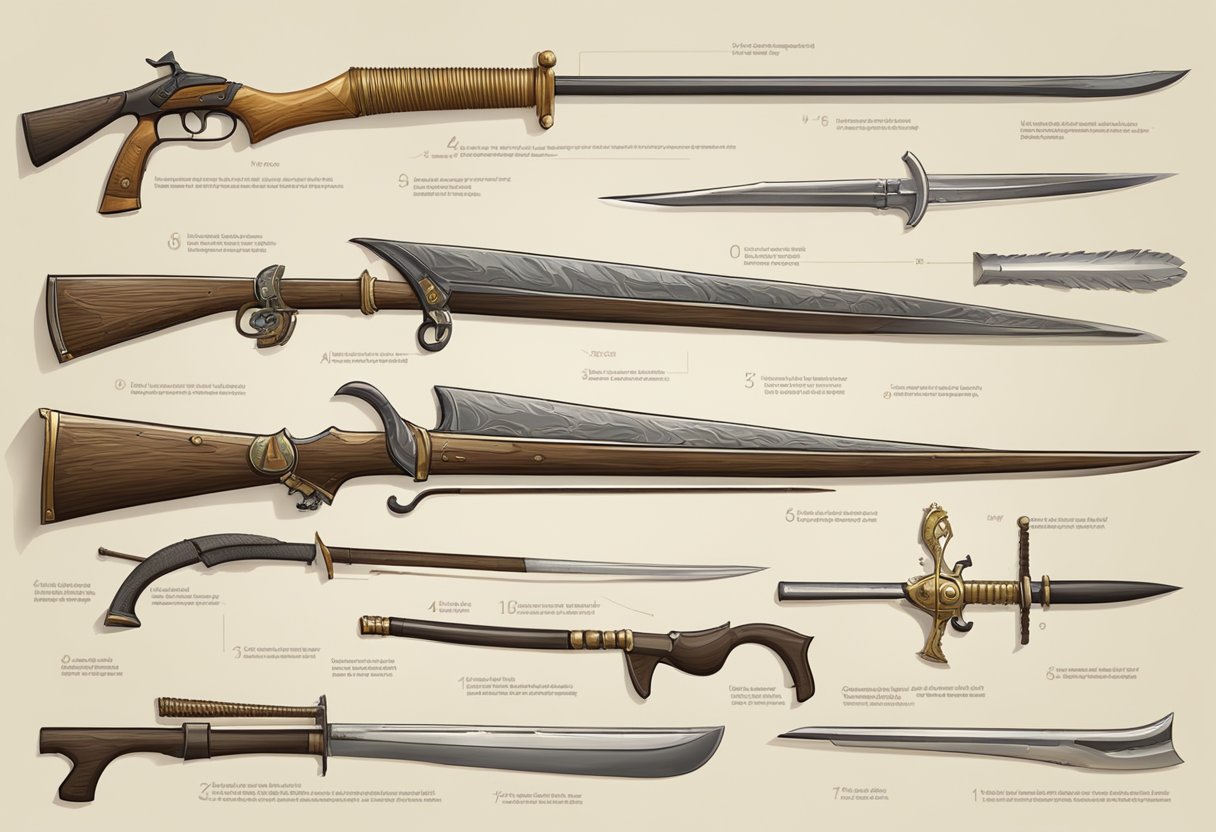Types Of Weapons
Weapons have been used throughout history for various purposes, including hunting, self-defense, and warfare. The evolution of weapons has been a continuous process, with new technologies and materials constantly being incorporated. The classification of weapons is based on various factors, including their mechanism of operation, range, and purpose.
In the military, weapons are used for combat and warfare. Different types of weapons are used for different purposes, such as rifles for long-range shooting and grenades for close-range combat. Law enforcement officers also carry weapons for self-defense, and civilians can own weapons for the same purpose. However, there are ethical and legal considerations that come with the use of weapons, and these must be taken into account.
Key Takeaways
- Weapons have been used throughout history for hunting, self-defense, and warfare.
- The classification of weapons is based on various factors, including their mechanism of operation, range, and purpose.
- Different types of weapons are used for different purposes in military combat and law enforcement, but ethical and legal considerations must be taken into account.
Historical Evolution of Weapons

Weapons have been an integral part of human history since prehistoric times. The evolution of weapons is a major driver of cultural evolution and human history up to today. This section will explore the historical evolution of weapons and how they have changed over time.
Prehistoric and Ancient Weapons
Prehistoric weapons were made from stone, bone, and wood and were used for hunting and self-defense. These weapons included clubs, axes, and spears. The development of the bow and arrow allowed for more accurate and longer-range hunting and warfare. Ancient civilizations like the Greeks and Romans also used swords in combat.
Medieval Weaponry
During the medieval period, weapons evolved to include more advanced technology. The development of gunpowder led to the creation of cannons and firearms, which revolutionized warfare. Knights used swords and shields, and archers used longbows. The use of armor also became common during this time.
Modern Warfare and Weaponry
The 20th century saw the development of modern warfare and weaponry. World War I saw the widespread use of machine guns, tanks, and chemical weapons. The atomic bomb, developed during World War II, marked the beginning of the nuclear age and the most destructive weapons ever created. Today, weapons continue to evolve with the development of drones and other advanced technologies.
Overall, the evolution of weapons has played a significant role in human history. From prehistoric times to modern warfare, weapons have been used for hunting, self-defense, and warfare. The development of new technologies has led to the creation of more advanced and destructive weapons.
Classification of Weapons
Weapons can be classified into various categories based on their mode of operation and usage. The following subsections describe the most common types of weapons:
Melee Weapons
Melee weapons are those that are designed for close combat and require physical contact with the target. They include blades, knives, sticks, and other similar weapons. These weapons are used for cutting, slashing, and stabbing.
Ranged Weapons
Ranged weapons are those that are designed to be used from a distance. They include rifles, shotguns, missiles, and other similar weapons. These weapons are used for hunting, self-defense, and military operations.
Explosive Devices
Explosive devices are weapons that use explosive material to cause damage. They include grenades, bombs, and other similar weapons. These weapons are used in military operations and terrorist attacks.
Chemical and Biological Weapons
Chemical and biological weapons are weapons that use chemicals or biological agents to cause harm. They include chemical weapons such as nerve gas and biological weapons such as anthrax. These weapons are banned under international law.
Overall, weapons can be used for various purposes such as hunting, self-defense, and military operations. It is important to use them responsibly and within the limits of the law to prevent harm to oneself and others.
Weaponry in Law Enforcement and Self-Defense
When it comes to law enforcement and self-defense, there are a variety of weapons available. These weapons can be divided into two categories: firearms and non-lethal weapons.
Firearms and Handguns
Firearms, particularly handguns, are commonly used by law enforcement officers and individuals for self-defense. Handguns are small and easy to carry, making them a popular choice for personal protection. They are also relatively easy to use and can be very effective in stopping an attacker.
However, it is important to note that firearms require a great deal of training to use safely and effectively. In addition, there are strict laws governing the use and ownership of firearms. It is important for individuals to familiarize themselves with these laws before purchasing a firearm.
Non-lethal Weapons
Non-lethal weapons are another option for law enforcement and self-defense. These weapons are designed to incapacitate an attacker without causing serious harm or death. Some popular non-lethal weapons include tasers, pepper spray, and batons.
Tasers are handheld devices that deliver an electric shock to an attacker, causing them to lose muscle control and fall to the ground. Pepper spray, on the other hand, is a chemical spray that irritates the eyes and respiratory system, causing temporary blindness and difficulty breathing. Batons are long, cylindrical objects that can be used to strike an attacker and cause pain without causing serious injury.
Non-lethal weapons can be a good option for individuals who are uncomfortable with the idea of using a firearm. However, like firearms, non-lethal weapons require training and practice to use effectively. It is also important to note that there are laws governing the use of non-lethal weapons, and individuals should be familiar with these laws before using them.
In conclusion, there are a variety of weapons available for law enforcement and self-defense. Whether an individual chooses to use a firearm or a non-lethal weapon, it is important to receive proper training and to be familiar with the laws governing the use of these weapons.
Technological Advancements in Weaponry
The field of weaponry has undergone significant technological advancements in recent years. These advancements have been driven by various factors, including the need for more precise and efficient weapons, the desire for greater safety for soldiers and civilians, and the need to reduce collateral damage. Two significant technological advancements in weaponry are Smart Weapons and Drones and Unmanned Systems.
Smart Weapons
Smart Weapons are weapons that use advanced technology to increase their accuracy and effectiveness. They are designed to be more precise and efficient than traditional weapons, reducing the risk of collateral damage. Smart Weapons use various technologies such as GPS, laser guidance, and advanced sensors to target specific objects accurately. They also have the ability to self-destruct if they miss their target, reducing the risk of harm to civilians.
One example of a Smart Weapon is the XM25 Counter Defilade Target Engagement System (CDTE). This weapon uses laser range finders and a digital compass to determine the distance to the target and the angle of the shot. It then uses a computer to calculate the trajectory of the projectile and adjust the fuse time. This allows the projectile to detonate at the precise moment it reaches the target, increasing its effectiveness.
Drones and Unmanned Systems
Drones and Unmanned Systems are another significant technological advancement in weaponry. They are unmanned vehicles that can be remotely controlled or operate autonomously. They are used for various purposes, including reconnaissance, surveillance, and targeted strikes. Drones and Unmanned Systems are becoming increasingly popular due to their ability to operate in dangerous environments without risking human lives.
One example of a drone is the MQ-9 Reaper. This drone is used for reconnaissance, surveillance, and targeted strikes. It has a range of over 1,000 miles and can stay in the air for up to 27 hours. The MQ-9 Reaper is equipped with advanced sensors and cameras that allow it to gather intelligence and track targets.
Overall, technological advancements in weaponry have led to more precise and efficient weapons that reduce the risk of collateral damage. Smart Weapons and Drones and Unmanned Systems are two significant examples of these advancements. These technologies have the potential to revolutionize the field of weaponry and increase the safety of soldiers and civilians alike.
Ethical and Legal Considerations
Weapon Control Laws
The use and possession of weapons are regulated by laws in most countries. These laws aim to prevent the misuse of weapons and ensure public safety. The laws vary from country to country, but generally, they cover issues such as who can own a weapon, what types of weapons are allowed, and how weapons can be used.
In the United States, the Second Amendment of the Constitution protects the right to bear arms. However, this right is not absolute, and the government can regulate the use and possession of weapons. For example, federal law prohibits the possession of firearms by convicted felons, drug users, and individuals with a history of mental illness.
In other countries, the laws may be more restrictive. For instance, in Japan, only shotguns and air rifles are allowed, and the process of obtaining a gun license is rigorous.
International Treaties and Agreements
Several international treaties and agreements regulate the use and possession of weapons. These agreements aim to prevent the proliferation of weapons of mass destruction and reduce the number of casualties caused by conventional weapons.
The Arms Trade Treaty, adopted by the United Nations General Assembly in 2013, regulates the international trade of conventional weapons. The treaty aims to prevent the transfer of weapons to countries where they may be used to commit human rights violations or fuel conflicts.
The Convention on Certain Conventional Weapons, adopted in 1980, prohibits the use of certain types of weapons, such as landmines and naval mines, which cause unnecessary harm to civilians.
In conclusion, ethical and legal considerations are crucial when it comes to the use and possession of weapons. Laws and international agreements aim to prevent the misuse of weapons and ensure public safety. However, the effectiveness of these measures depends on how well they are implemented and enforced.






